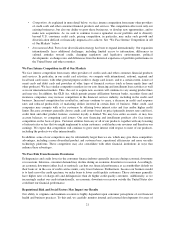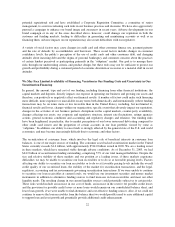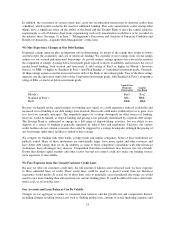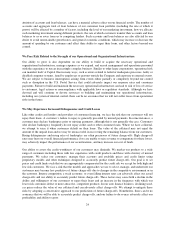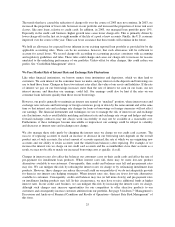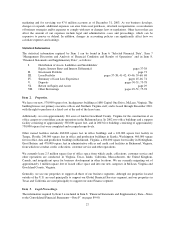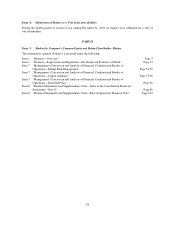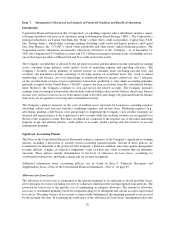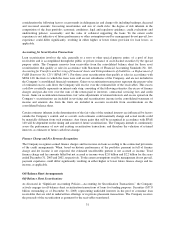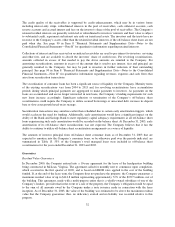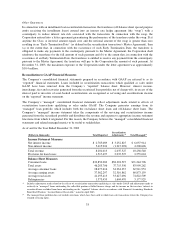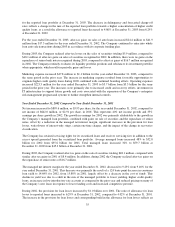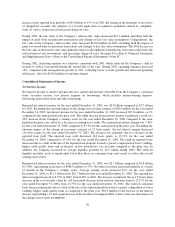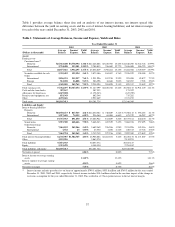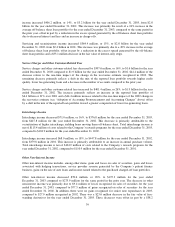Capital One 2003 Annual Report Download - page 49
Download and view the complete annual report
Please find page 49 of the 2003 Capital One annual report below. You can navigate through the pages in the report by either clicking on the pages listed below, or by using the keyword search tool below to find specific information within the annual report.consideration the following factors: recent trends in delinquencies and charge-offs including bankrupt, deceased
and recovered amounts; forecasting uncertainties and size of credit risks; the degree of risk inherent in the
composition of the loan portfolio; economic conditions; legal and regulatory guidance; credit evaluations and
underwriting policies; seasonality; and the value of collateral supporting the loans. To the extent credit
experience is not indicative of future performance or other assumptions used by management do not prevail, loss
experience could differ significantly, resulting in either higher or lower future provision for loan losses, as
applicable.
Accounting for Securitization Transactions
Loan securitization involves the sale, generally to a trust or other special purpose entity, of a pool of loan
receivables and is accomplished through the public or private issuance of asset-backed securities by the special
purpose entity. The Company removes loan receivables from the consolidated balance sheet for those asset
securitizations that qualify as sales in accordance with Statement of Financial Accounting Standards No. 140,
Accounting for Transfers and Servicing of Financial Assets and Extinguishments of Liabilities—a Replacement of
FASB Statement No. 125 (“SFAS 140”). For those asset securitizations that qualify as sales in accordance with
SFAS 140, the trusts to which the loans were sold are not subsidiaries of the Company, and are not included in
the Company’s consolidated financial statements. Gains on securitization transactions represent the present value
of estimated excess cash flows the Company will receive over the estimated life of the receivables. This excess
cash flow essentially represents an interest-only strip, consisting of the following estimates: the excess of finance
charges and past-due fees over the sum of the return paid to investors, contractual servicing fees and credit
losses. Gains on securitization transactions, fair value adjustments of retained interests and excess spread on the
Company’s securitizations are included in servicing and securitizations income in the consolidated statement of
income and amounts due from the trusts are included in accounts receivable from securitizations on the
consolidated balance sheet.
Certain estimates inherent in the determination of the fair value of the retained interests are influenced by factors
outside the Company’s control, and as a result, such estimates could materially change and actual results could
be materially different from such estimates. Any future gains that will be recognized in accordance with SFAS
140 will be dependent on the timing and amount of future securitizations. The Company intends to continuously
assess the performance of new and existing securitization transactions, and therefore the valuation of retained
interests, as estimates of future cash flows change.
Finance Charge and Fee Revenue Recognition
The Company recognizes earned finance charges and fee income on loans according to the contractual provisions
of the credit arrangements. When, based on historic performance of the portfolio, payment in full of finance
charge and fee income is not expected, the estimated uncollectible portion is not accrued as income. Total
finance charge and fee amounts billed but not accrued as income were $2.0 billion and $2.2 billion for the years
ended December 31, 2003 and 2002, respectively. To the extent assumptions used by management do not prevail,
payment experience could differ significantly resulting in either higher or lower future finance charge and fee
income, as applicable.
Off-Balance Sheet Arrangements
Off-Balance Sheet Securitizations
As discussed in “Significant Accounting Policies—Accounting for Securitization Transactions,” the Company
actively engages in off-balance sheet securitization transactions of loans for funding purposes. Securities ($37.8
billion outstanding as of December 31, 2003) representing undivided interests in the pool of consumer loan
receivables that are sold in underwritten offerings or in private placement transactions. The Company receives
the proceeds of the securitization as payment for the receivables transferred.
31


